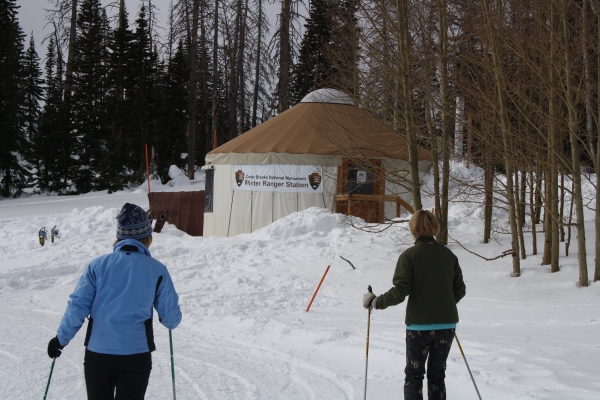
A great winter activity for snow lovers is cross-country skiing or snowshoeing in Cedar Breaks National Monument. Once heavy snow hits the park’s main road, Utah Highway 148 (usually by mid-November), the road is not plowed, so skies and snowshoes become an exhilarating winter alternative to driving. Snowmobiles are also allowed, but many of us prefer the lovely quietness of traveling under the power of our own legs.
Furthermore, you’re guaranteed enough snow to make it fun for the next couple of months, because the park averages about 15 feet of snow a year.
You can join a guided snowshoe walk with a Cedar Breaks park ranger; the park offers guided snowshoe walks on Saturdays through February. Reservations are needed. The rangers provide snowshoes and instruct participants on how to use them.
If those dates don’t happen to fit your work schedule, though, it is an easy activity you can do on your own as long as you are very prepared for winter travel in remote country with unpredictable conditions. Georg’s Ski Shop in Brian Head rents snowshoes and cross-country skis.
From Brian Head Resort a 3-mile drive brings you to the trail head, a plowed parking area at the junction of Cedar Breaks Scenic Highway and Utah Highway 148. Here you just climb up the snow bank and you will find a wide, flat, snow-groomed road within a subalpine fir forest.
In winter the park operates a winter ranger station in a yurt — an American adaptation of the Mongolian nomad’s circular tent. The yurt is only 1 mile or so from the trail head. If you are cold, it is a great place to get a cup of hot chocolate and to warm up by the wood stove. It can be actually cozy in there; on my last visit the thermometer on the wall read 75 degrees. The yurt is staffed on Saturdays from 9 a.m. to 3 p.m. through February.
Be sure to take in one of Cedar Breaks’ many viewpoints. Below the rim is a natural amphitheater 2,000 feet deep. It is filled with fanciful shapes of limestone such as hoodoos, arches, fins and columns. The vibrant colors of the canyon are a result of oxidized minerals. Iron results in the orange and red tones and manganese gives off the purple shades. Seeing these shapes and colors popping out of a landscape filled with snow is a sight even more striking than the same vista in summer.
The amphitheater was formed over millions of years, mostly through erosion. It is also still changing, because of frost wedging. When water gets into the cracks of the rock in cold weather, it then freezes and therefore expands the crack. Temperatures drop below freezing here an average of 250 nights a year. Many of those nights are followed by a day warm enough to melt some snow or ice and refill the cracks, which will freeze again within 24 hours. This means that the erosion is very fast as geology goes.
The weather here is much cooler than the surrounding area. January average temperatures are 49 degrees for a maximum with the overnight lows often below zero. Furthermore, the park elevation is about 10,000 feet, so strenuous outdoor activities such as snowshoeing and skiing can feel more exhausting than at other places. Especially with extra exertion, there is a risk of altitude sickness for some people.
Georg’s Ski Shop is open from 9 a.m to 5 p.m. Monday and Tuesday, 8:30 a.m. to 6 p.m. Saturday and 8:30 a.m. to 5 p.m. Sunday at 612 S. Highway 143, Brian Head. Call 435-677-2013 for more information or visit www.georgsskishop.com/.
Cedar Breaks National Monument is only accessible in winter by cross-country skiing, snowshoeing or snowmobiles. The yurt is open for day use only, when staffed on weekends, weather permitting. For guided snowshoe walks please make a reservation by calling 435-586-9451, ext. 4425, or visit www.nps.gov/cebr/.
If you plan on staying overnight, there are numerous lodging opportunities in Brian Head, Parowan and Cedar City. Visit www.brianhead.com/ or www.scenicsouthernutah.com/ for more information.
— Many of Deborah Wall’s columns have been compiled in the book “Base Camp Las Vegas, Hiking the Southwestern States.” She is also the author of “Great Hikes, a Cerca Country Guide” and a co-author of the new book “Access For All, Seeing the Southwest With Limited Mobility.” Wall can be reached at Deborabus@aol.com.
^
Directions
From Boulder City, drive about 25 miles north on U.S. Highway 93/95 to Las Vegas. Merge right onto Interstate 15 north and follow about 180 miles to Exit 75, at Parowan, Utah. Take Utah Route 143 for 16 miles to Brian Head.